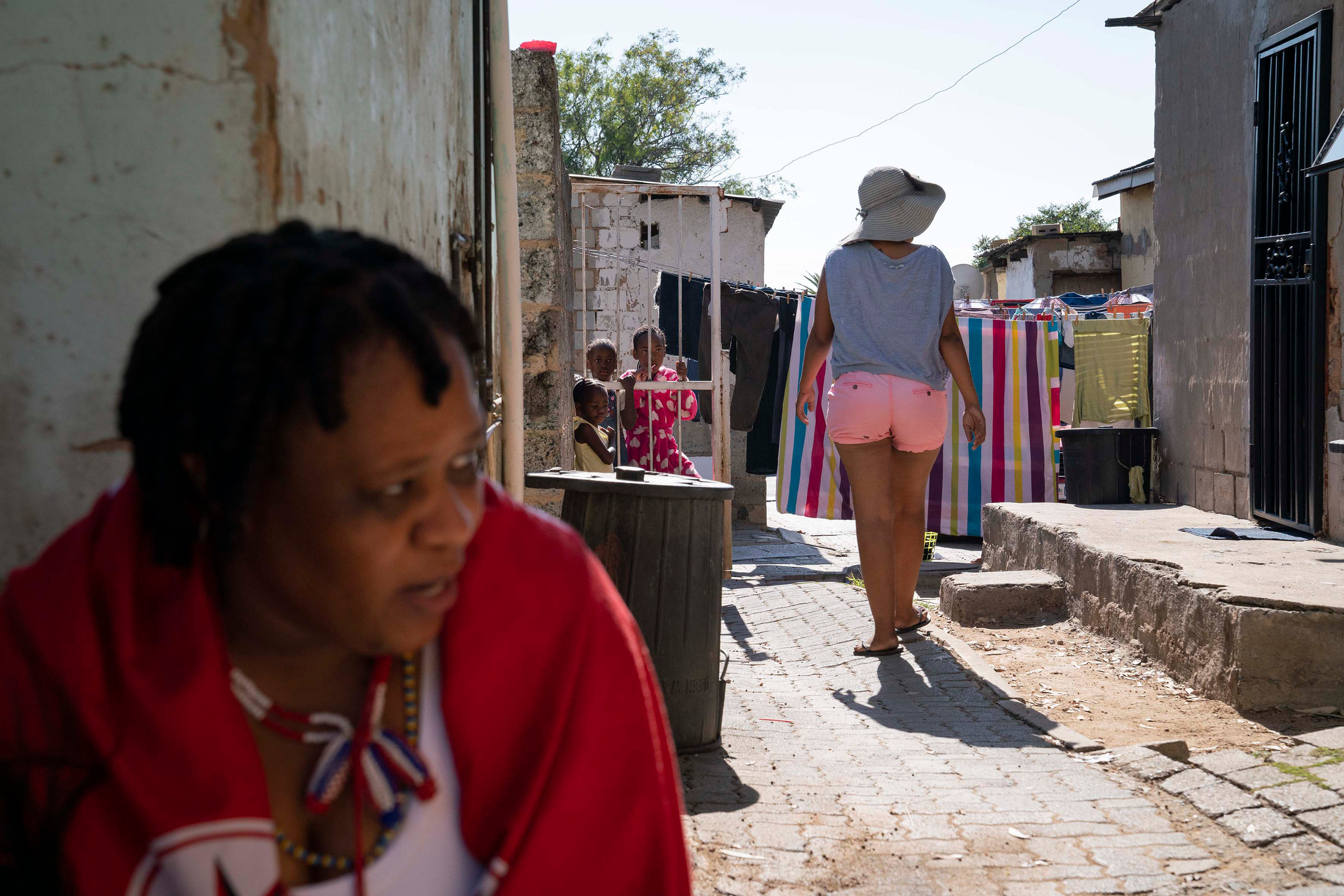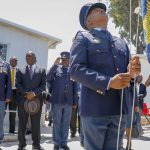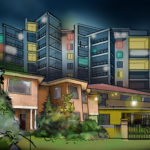The healers of Alex
A history of local conflict resolution in one of South Africa’s oldest townships has been taken up by a council of traditional healers. Their next struggle is for recognition.
Author:
8 April 2019

Ndosi Dlamini had been a stranger to his family for as long as any of them could remember. His son, Solomon, died not knowing his father. Brenda Sibiya, Solomon’s daughter, never met her grandfather.
Nevertheless, Sibiya can describe the old man in detail. He is short – about as short as she is, she says, smiling fondly – and light in complexion with long, brown dreadlocks. He is almost always cheerful and trusted by anybody who meets him.
Sibiya’s intimate portrait of Dlamini began in a dream. He appeared to her in anger, brandishing a sjambok and showing little of his cheer as he scolded Sibiya about her ignorance of him and her ancestors, whose clan name – amaZizi – he revealed to her for the first time.
This is how Sibiya’s life as a traditional healer, and her near-constant conversation with Ndosi Dlamini ever since, began.
In the gulf left by formal institutions
As Sibiya’s “spiritual guide”, Dlamini, together with the amaZizi pantheon, has come to play an unlikely part in resolving conflicts in Alexandra. His granddaughter serves as the chairperson of Buyisa, a council of traditional healers that acts as a customary mediation court in Alexandra, north of Johannesburg.
Buyisa mediates on cultural disputes and conflicts arising from traditional healing – accusations of witchcraft, breakdowns in relationships between gobelas (traditional teachers) and thwasas (traditional students).
Increasingly, however, the council is helping to resolve a host of the township’s social and family disputes. According to its seven members, Buyisa’s services are in increasingly high demand. One reason is the unique nature of the council’s expertise. Another is that oversubscribed formal institutions in Alex are unable to cope with conflicts arising among the township’s residents.
Related article:
South African Police Service (SAPS) resource allocation data – made public during a recent equality court case brought by the Social Justice Coalition, Equal Education and the Nyanga Community Policing Forum – shows that Alex’s police station is severely under-resourced when compared with those in Johannesburg’s wealthier neighbourhoods.
There are 10 police officers per 1 000 people living in Rosebank and four officers per 1 000 Parkview residents. In Alex, there are 1.7 police officers serving every 1 000 people, which is also below Gauteng’s average of 2.3. This is despite the township having a murder rate more than five times higher than the two leafy northern suburbs.

An unusual trial
An example of a conflict beyond the capacities of these over-stretched institutions began at a hearing on 31 January.
Peter*, an elderly traditional healer, was accused of witchcraft, one of the greatest potential disgraces for somebody of his vocation. He lived side by side with his accuser, Joyce*, in a shack settlement on Alex’s western edge.
Complainants such as Joyce come to Buyisa by way of word-of-mouth recommendations or through referrals from the Parliamentary Constituency Office and other local organisations. They fill in a form outlining their grievance and Buyisa then considers whether or not to involve other bodies – serious issues such as gender-based violence or child abuse require police intervention – before scheduling a hearing.
Scarcely able to hold back tears, Joyce alleged during her hearings that an otherwise unremarkable neighbourly quarrel had ended in Peter lifting his induku – a short stick used by traditional healers – in anger and pointing it towards her stomach. She said she had felt bilious ever since.
Evidence of Joyce’s accusations proved slim during the hearings, which stretched over a number of weeks. As they drew to a close, however, it emerged that she was struggling with troubles beyond those she felt in her stomach. Joyce’s boyfriend had become abusive.
Buyisa’s social functions came to the fore. The council, which concluded that much of Joyce’s anguish stemmed from the abuse, played a decisive role in putting her in touch with social workers and counsellors in Alex.
A child of Alex
Buyisa is part of a rich history of locally organised conflict resolution in Alex that has veered from progressive to reactionary. In the 1980s, street committees effectively wrestled control of the township from the grip of the apartheid state and, at various stages over the past decade, xenophobic violence has been channelled through local structures.
Sibiya was tied to this history from an early age, and to the township social movements that would eventually play a decisive role in ending apartheid. She “was lucky to have been born” in her father’s house in 1973.
The police killed her mother, Aida, when the Soweto uprisings spread to Alex three years later. While Sibiya was never able to confirm exactly what happened – “It is still a story that I don’t understand today,” she says – she has narrowed Aida’s death down to the bullet wounds in either her chest or head by listening to the accounts of people who were on the streets during the uprising.
Barney Mokgatle, a native of Alex and veteran of the 1976 revolts, told New Frame that any tally of the dead from that time is made in vain.
On 17 June, a day after he led students through the streets of Soweto, Mokgatle was in Alex coordinating the support that would spill into the township’s streets the following day. The brutality of the police force ensured that there could never be a reliable count of the lives lost to the uprisings, said Mokgatle.

Where neighbours make politics
Sibiya was raised by her father in the aftermath. Solomon, a member of the Alex Civic Organisation, dedicated a great deal of his time to housing, clean streets and the provision of toilets in the township. He often took a young Sibiya along with him to help neighbours with matters as insignificant as changing a lightbulb or as serious as domestic violence, where he would “address conflicts in such ways that we would leave people shaking hands, leave people coexisting harmoniously”.
Solomon, who Sibiya describes as a “community member [and] an activist”, loved to cook. Neighbours regularly came by for his famously huge spreads, the dumplings, beetroot, boere beans (green beans mashed with potato and onion), pumpkin and freshly slaughtered chicken (he had no time for frozen chicken, which he called “mortuary chicken”) that Sibiya and many others called “Sunday food” or “your seven colours”. Sorghum beer, music and dancing almost always followed.
In Sibiya’s view – which is confirmed in numerous written histories of Alex – the richness of the township’s politics and its history of local conflict resolution, which stretch from her hand-in-hand visits with Solomon through to Buyisa, can be ascribed to the township’s density.
Sibiya cites the countless yards around which most homes in Old Alex, including her own, are organised: “Is there any other township where it’s one yard housing 28 families?”
Related article:
“[Alex] teaches us to get along,” she says. “It teaches us to even pick fights. It teaches us that, when I don’t have, it’s easy for me to go just opposite; two feet and I’m in my neighbour’s house. I can ask for bread if I don’t have bread. I can ask for milk for my children.”
Despite being a low-rise neighbourhood (homes rarely rise above two floors), population density in Alex is four times that of Soweto, the township to which it is most often compared. At the time of the 2011 census, there were about 26 000 people living in each of Alex’s seven km². That outstripped densities in some of Johannesburg’s inner-city flatlands. There were 19 400 people per km² in Yeoville, for instance.
“We are that connected,” continues Sibiya. “[Alex] teaches you how to love, how to be close to somebody … It’s not easy [in] Alex. It’s not easy to mind your own business. We are on each other’s toes. Whether it’s good, whether it’s bad, there is something that you learn.”
According to Sibiya, these are difficult lessons to learn if you are “locked up” alone in your own yard.

The teacher and her student
The density of the yard and the neighbourliness it imposes on Alex’s residents was in full view at a recent ukuhlanganisa idlozi ceremony held outside Sibiya’s home. The ceremony was intended to bring Sibiya’s ancestors into a closer relationship with those of her thwasa, Gogo Nkanyezi.
The young disciple – performing dances that would please her ancestors before calling on them in chants to help her divine the location of objects hidden throughout the yard – rarely missed a beat. Dodging and weaving between the morning foot traffic in and out of the yard, or the fresh laundry being hung by neighbours, the young healer honed in on her prizes.
One neighbour was woken by the frenetic rhythm beaten out with plastic pipes by Sibiya and two other traditional healers against hides stretched over large plastic canisters throughout the ceremony.
Still half asleep, she snarled in a whisper about the early hour of the noise. Maintaining the integrity of the ceremony and resolving the tension that erupted in response – precisely the kind of “fight” that Sibiya had referenced – required expert negotiation and compromise between the neighbours.

Where there are witches
Practices like Nkanyezi’s ukuhlanganisa idlozi were first outlawed in South Africa in 1895, when the Witchcraft Suppression Act (a law the apartheid government revived in 1957) criminalised traditional healers and their patients. The legislation claimed that customary practices were backward, at a time when Western biomedicine itself was alarmingly primitive.
Opium and arsenic were readily available from the chemist. Sigmund Freud prescribed cocaine to his patients. Even Florence Nightingale – widely attributed with the professionalisation of modern nursing despite the fact that her imprudence contributed to untold deaths during the Crimean War – subscribed to the miasma theory, in which bad smells were understood to be the underlying cause of disease. And as recently as the turn of the 20th century, Americans were able to order heroin by post from German pharmaceutical giant Bayer.
The Witchcraft Suppression Act has never been repealed. While traditional healers are no longer outlawed, witchcraft remains a criminal act under South African law.

The most recent amendments to the legislation, made in 1997, removed its corporal punishment provisions. People guilty of witchcraft can no longer be whipped (in the past, these whippings were limited to a maximum “ten strokes”). They can, however, pay a fine. Or be imprisoned.
Attempts have been made to bring traditional healers into the formal institutional fold, but loopholes remain. The Traditional Health Practitioners Act passed in 2007, for instance, criminalises unregistered traditional healing. A regulator where healers can register, however, has not been established, rendering the practice of the country’s 200 000 traditional healers (according to some department of health estimates) in theory, criminal.

Recognition required
The gaps in the recognition of traditional healing have not gone unfelt at Buyisa.
Joyce’s evidence of Peter’s alleged witchcraft amounted to little in the end, but that is not always the case. To Buyisa’s frustration, it is often unable to act meaningfully in cases dealing with gross abuses of practice by traditional healers – sometimes, it says, even bordering on witchcraft.
The council, which has started reaching out to the City of Johannesburg and the Commission for the Promotion and Protection of the Rights of Cultural, Religious and Linguistic Communities, says its next frontier must necessarily be greater institutional recognition as a result.
When Buyisa members joined the Traditional Healers Organisation in a recent march on the Gauteng legislature to “end medicine apartheid” and include traditional healing more fully in South African healthcare frameworks, contestation on what recognition means to different healers bubbled below the surface.
Like Buyisa, Shoriel Aubrey, a 64-year-old Soweto-based homeopath who prescribes remedies of turmeric, ginger and cinnamon, was marching for recognition, especially increased responsibility in clinics and hospitals. But where the Alex healers are trying to forge meaningful partnerships with government, Aubrey admonished Parliament for “interfering in spiritual issues”.
“We are incited by people who are not flesh,” he said. “We cannot be controlled by somebody in Parliament.”
*Not their real names


